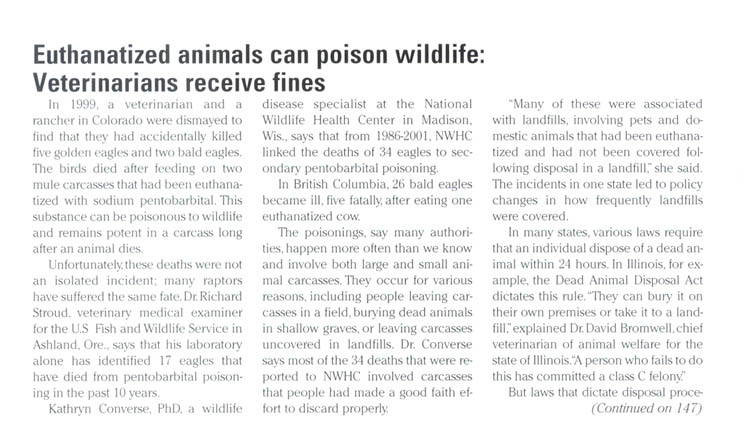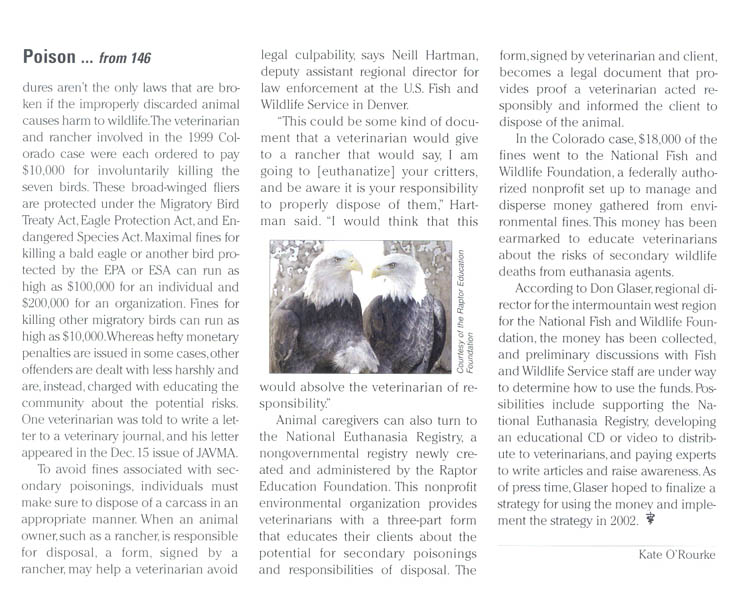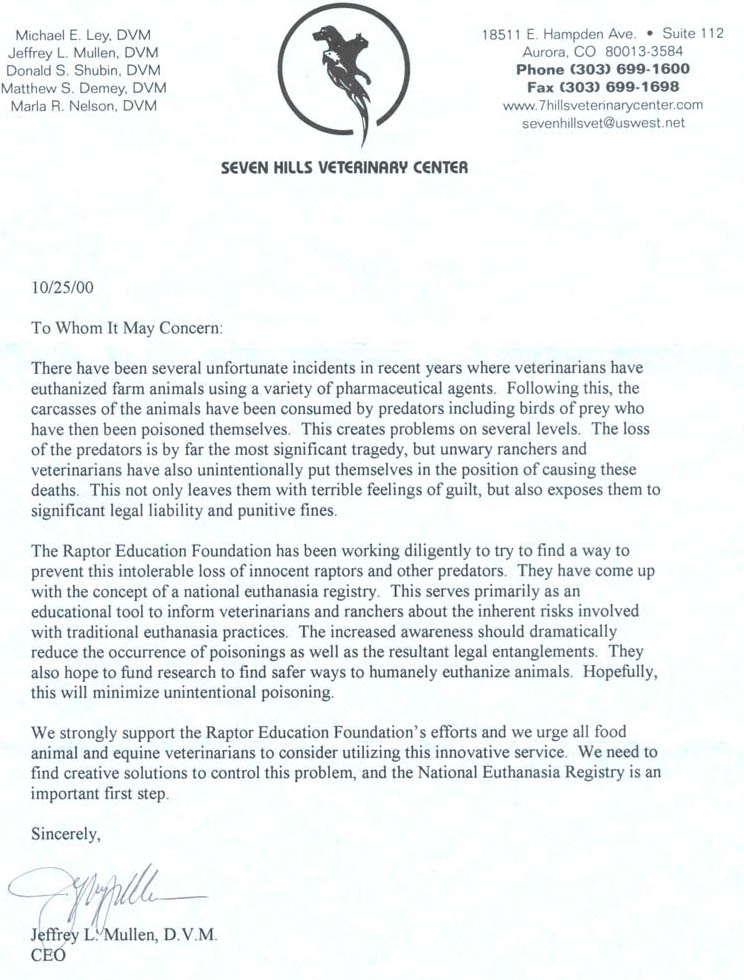National Euthanasia Registry launched on the world wide web October
15, 2000.
Awareness and promotional campaign to follow.
American Veterinary Medical Association Report Endorsement |
Cat
Kills Eagle |
![]()
The National Euthansia Registry depends on donations to keep this site up and available to all interested parties. Your help is greatly appreciated.
| $25 donation | $50 donation | $75.00 donation | $100 donation |
NATIONAL EUTHANASIA REGISTRY LAUNCHED
Date Line: Denver, November 10, 2000
For decades wildlife species have been dying at the hands of unsuspecting veterinarians. When a rancher must euthanize a large animal, a lethal injection of sodium pentobarbital is typically administered. This deadly drug quickly puts the animal to sleep and then stops the heart and respiration. Now comes the problem. What to do with a carcass that may weigh over a thousand pounds and is saturated with deadly poison? Some ranchers may sell it to a rendering plant which turns it into pet food. Yet even the FDA is not sure that rendering the carcass breaks down the drug(s) sufficiently.
But what if the rancher cannot have the animal carcass picked up? Retired U. S. Fish
& Wildlife Service agent Terry Grosz shared this experience: a hungry mother grizzly
coming out of her den, with two cubs to feed, smelled a decaying carcass
and dug down through ten feet of earth to get at the meat. She and her cubs died. The FDA
acknowledges that they know of no protocols for the disposal of euthanized carcasses, so
ranchers and veterinarians continue to be uninformed participants in the tragic killing of
scavenging species from eagles to bears.
The Raptor Education Foundation (REF), a non-profit environmental education organization, was asked by a rancher and veterinarian to look at this problem.
They had
r(1999) discovered seven dead eagles on the ranch, poisoned by eating the carcass of two
mules euthanized with sodium pentobarbital. It took courage to report this disaster. The
rancher and veterinarian could have just buried the seven dead eagles, and despite being
fined tens of thousands of dollars, they knew their horrible lesson had to be publicized.
Here is where the story gets even more interesting:
You probably think that the pharmaceutical companies have proper warning labels on these lethal products, or that veterinary schools at least educate their students about the issue. Yet none of the veterinarians we talked with ever had this mentioned during their schooling and drug labels never address the issues. In fact, Ft Dodge Animal Health owned by American Home Products, the manufacturer of the euthanasia agent Sleepaway, responsible for killing the seven eagles, addressed our questions by stating the use in this case was "off label. " It was simply "not their responsibility, besides there really wasn’t any profit in the drug anyway".
At the behest of the ranch, REF has created a unique service to protect wildlife, ranchers and veterinarians as well as provide a unique vehicle to address this tragedy:
REF’s National Euthanasia Registry is the only service that protects
veterinarians and wildlife by educating veterinarians and their clients about the dangers
involved in large or small animal euthanasia. The Registry also diminishes the liability a veterinarian will face should his clients not act responsibly. Everyone wins, yet nobody
wants to spend the money to spread the word. Maybe the representative of Ft. Dodge
Animal Health was right: "There’s just no profit in it".
![]()
Breaking News...
Pet Food Industry Poisonings? Are You Feeding Contaminated Pets to Your
Pets?
March 16, 2002: Hello, I have found your site extremely interesting and informative. For the last twelve years I have been researching the commercial pet food industry and have been very concerned about some of the ingredients used in these foods including euthanized animals, cats, dogs, cattle and horses. The FDA/CVM recently completed a study with regard to levels of sodium pentobarbital found in dry dog foods. This drug was found in a number of foods that they tested, but the FDA/CVM seems to feel that the levels are not high enough to cause a problem. I have my doubts on this issue. They state that their studies did not show that euthanized dogs and cats were found in the foods they tested and suspect that this drug was coming from cattle and horses that were rendered and processed into pet foods. The rendering process does not degrade this drug. I am aware that literally tons of dogs and cats, euthanized with sodium pentobarbital, are sent to rendering and am aware that pet food companies do use this rendered material.
I was wondering if you had heard of problems encountered by pets eating animals that were euthanized with this drug?
Your input would be greatly appreciated.
Sincerely, Ann Martin: Ontario Canada
Editor's Note: -As such, we have not encountered any direct evidence that companion animals have been affected by consuming pet food made of rendered animals, however, we did not pursue this area of research. We were brought in because of the wildlife deaths associated with chemically euthanized ranch stock. It it is quite disconcerting that the pet food industry would be recycling pets via the pet food they sell. Should pets be eating pets, and are the various drugs that have been introduced into the pet during its lifetime broken down in the rendering process, or how about prions? Have we forgotten the BSE (Mad Cow Disease) lesson from England so quickly? Ms. Martin has two books out dealing with this issue: Food Pets Die For and Protect Your Pet, both published by NewSage Press of Portland Oregon. These are must reads to protect your pet's health. She has been way ahead of the curve in this area.
More From Ms. Martin:
I reside in Ontario, Canada and it was Dr. Wendell Belfield, whom I had communicated with for some time, that originally mentioned that dogs and cats were being euthanized and used in pet foods. I did some digging right here in the city where I live, checked with vets as to who was picking up the carcasses, and then followed the trail. The animals were being picked up by a dead stock operation, shipped to a broker about 300 miles from here and he in turn was selling them to rendering plants in Montreal, which ever one was paying the highest amount at the time. The Minister of Agriculture in Quebec advised that these animals were rendered along with diseased cattle (Editors note- what did the cattle die from?) and sold as meat meal to the pet food industry. When I went back to the vets with this info all stated that they "assumed" the animals were being cremated. They immediately ceased using this dead stock removal company and have since had the animals cremated at the local Humane Society. Nearly all the pet food sold in Canada is coming from the US and I then began my investigation as to what was happing there. This has been a dirty little secret that has been kept hidden for many years and I guess you might say I was the first to blow the lid of this operation. My books are widely distributed in the US, my publisher is in Portland Oregon. The rights to publish have recently been bought in Japan and the UK. As for having the foods tested. The FDA/CVM recently completed their testing on some commercial pet foods and over half contained sodium pentobarbital. I must say that they really did not test that many compared to the number of pet food companies that are out there. It is difficult to have these foods tested, costly, and every lot varies depending on the mix of animals they use in the raw materials. I'd be suspect of any foods originating in California as that state renders far more companion animals they do other states.
The problem is that we don't know what the long-term effect is on animals ingesting this material on a daily basis. No studies in this area have been undertaken. The FDA/CVM does not plan to take any stand on eliminating this drug from pet foods as they state that it is only as small amount that is coming through. If they FDA would take a stand and eliminate this drug from use in pet food it would pet an end to most animals being euthanized with this drug.
I have spoken to a number of state veterinarians and they basically say that the label on the drugs states "Not for use in animals intended for food," and they interpret this to mean food for humans as well as animals. I cannot get the FDA to clarify if it is food for humans or food for humans as well as animals. If it both then there are a lot of illegal aspects to what is happening.
More developing....
![]()
CURRENTLY WAITING TO SEE IF FT. DODGE ANIMAL HEALTH
(Owned by
American Home Products)WILL ACCEPT ANY RESPONSIBILITY IN THE MATTER
THAT
LED TO THE DEATH OF SEVEN EAGLES BY THEIR INADEQUATE LABELING
OF SLEEPAWAY, THEIR
EUTHANASIA AGENT.
November 27, 2001: NER offices
were contacted by reporter Kate O'Rourke,
from AVMA, (American Veterinary Medical Association) who was gathering
information on another story about eagle deaths caused by improper disposal
of a euthanised calf carcass in Washington State. Since the launch of the
National Euthanasia Registry on the
web last year, NER officials were waiting
to see what, if any, actions would be taken
by U.S. Fish & Wildlife officials or
those from the pharmaceutical industry to
implement any sincere efforts to
begin the process to avoid preventable deaths
of wildlife species.
As far as we can tell, nothing has happened, except for the fact
that at least
two more eagles have died. The funds that the U.S. Fish & Wildlife Service
collected via fines assessed against the parties involved in the original death
of 7
eagles, which the Service had agreed would be directed to implementing
an educational campaign by REF, were instead sent to the National Fish &
Wildlife
Foundation. Where those dollars went from there we do not know.
Apparently the Service has put the burden on the veterinarian in
Washington
state to get the word out. The Service had a plan presented to them by
Raptor
Education Foundation to get the word out over one year ago, and as far as we
can tell they did nothing with
it- so who is responsible for the death of those eagles
in Washington state?
![]()
American
Veterinary Medical Association Reports
on Raptor Education Foundation's National Euthanasia Registry
Digital Version


Printed in Volume 220, No. 2, January 15, 2002 Journal of the American Veterinary Medical Association
![]()
October 7, 2002- From Tom R. MacKenzie, Chief, Media
Relations- U.S. Fish & Wildlife Service
Note: Despite REF's research into this problem years ago, designing a simple
solution, Ft. Dodge Animal Health- American Home Products, the company making
the deadly agents, has done nothing to seriously and sincerely deal with the
massive education program required to deal with this issue. What's a couple of
dead eagles?
In West Palm Beach, Florida, this summer, a dead adult American bald eagle (Haliaeetus leucocephalus) was discovered by a work crew at a landfill. The eagle was found lying next to the carcass of a dead cat. A Special Agent of U.S. Fish and Wildlife Service's Division of Law Enforcement conducted an investigation at the landfill, seizing the dead eagle and cat as evidence. No visible sign of trauma to the eagle was present, leading the agent to suspect the cause of death as poisoning. Scientists at the U.S. Fish and Wildlife's National Wildlife Forensic Laboratory confirmed the presence of pentobarbital in the crop contents and the liver of the eagle. Pictures...
All the facts of the investigation indicate that a veterinarian clinic or animal shelter killed the cat with pentobarbital, and the carcass was then deposited in the landfill where it was fed upon by the eagle with tragic results. Unfortunately, this is not a unique event. Less than a year ago, bald eagles were found by Service Special Agents to be similarly poisoned by feeding on poisoned cats and dogs in a landfill in South Carolina. It is important that veterinarians and animal shelters be aware of the consequences of the improper disposal of deceased animals to wildlife and the environment.
Unfortunately, bald and golden eagles and other scavengers are being poisoned when they consume improperly disposed of poisoned domestic animal carcasses that contain pentobarbital residue. Pentobarbital, a barbiturate drug, is widely used by veterinarians to anesthetize animals for surgery. It is also the primary active ingredient in most drugs available to veterinarians and animal shelters. Veterinarians and others are responsible for the proper use of this Schedule IV drug. A Schedule 4 drug is a controlled substance that can be used for medical treatment in the United States.
Such incidents have occurred sporadically at various locations throughout the United States according to Dr. Richard Stroud, Pathologist at the U.S. Fish and Wildlife Forensics Laboratory in Ashland, Oregon. Since 1990, similar incidents involving eagles have been investigated by the U.S. Fish and Wildlife Service's Division of Law Enforcement. Dr. Nancy Thomas, reports that an additional 17 cases involving 26 eagles have been examined by the Wildlife Health Research Center, Madison, Wisconsin since 1980. Several of the incidents have involved the improper burial of animals killed at humane shelters and taken to a local landfill for disposal. In other cases, veterinarians have poisoned large animals such as horses and have not instructed the owners on proper disposal of the carcass.
Eagles, vultures, other migratory birds, and other wild scavengers may ingest enough meat from a poisoned carcass to die or become intoxicated or anesthetized, becoming easy prey for predators. In British Columbia, Canada, 26 eagles were reported to have been poisoned, five fatally, from feeding on a single euthanized cow carcass.
Pentobarbital-laced carcasses should be buried or burned. When inadequately covered or left in the open, the carcasses are a natural attraction for scavengers. Eagles and other scavengers become accustomed to feeding in areas where carcasses are dumped and these areas become feeding stations.
Eagles may be particularly susceptible to pentobarbital poisoning. Poisoning may be further enhanced by their habit of consuming the visceral of a carcass first. The concentration of pentobarbital may be greater in the liver and spleen than in other portions of the carcass. The stability of the active form of the drug in a decomposing carcass is not known and may retain the ability to kill for an extended period of time. In cold climates, carcasses may even retain the potential for poisoning wildlife throughout the winter.
![]()
I read about the Foundation, the Registry and its efforts in the AVMA Journal today. Great work. Obviously here in San Diego the problems are not the same as food animals are few and far and equine disposal is not an issue to my knowledge. However, it has occurred to me that even euthanized dogs/cats that are buried by a rural home may pose a threat to wildlife suffering. We have almost no bald eagles here (we do have 13 nesting pairs of resident golden eagles though) but all wildlife in general protected or not seems at risk. I would like to bring this issue to the attention of our local membership almost 600. Perhaps an added statement on their euthanasia consent forms that would inform clients of proper burial disposal for wild animal safety. Can you assist me please?
Helping animals...Thank you
Pauline White
Administrator
San Diego County Veterinary Medical Association
Editors Note: Our special form covers any type of disposal situation, with any type of animal. Many people have asked about making their own form-the legal problem without a third party holding a copy (which is one of the functions of NER) is that you have a greater degree of difficulty proving the client was notified at the time of the euthanasia. You would have to prove you did not simply notify the client after-the-fact. An independent registry solves that issue easily, plus the other benefits from belonging to NER are important for a holistic approach to the challenges involved. In researching the legal issues, we found the most cost effective way of protecting the veterinarian, especially when you consider the costs associated with litigation, is independent third part verification.
I
![]()

![]()
Take that important first step and work with NER to protect wildlife
and
further the education and research mission of the National
Euthanasia Registry- Sign Up today!
![]()